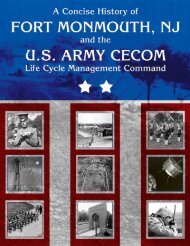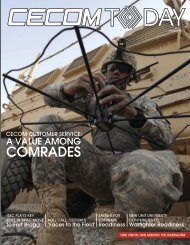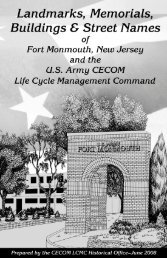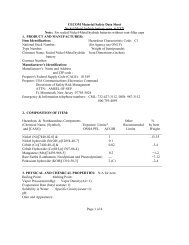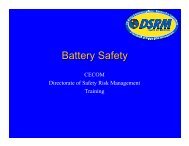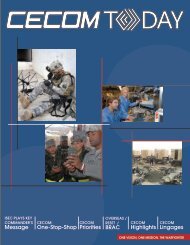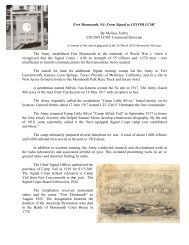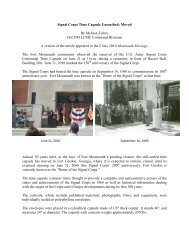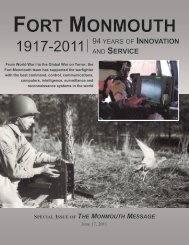A History of the Commanding Officers at Fort Monmouth ... - CECOM
A History of the Commanding Officers at Fort Monmouth ... - CECOM
A History of the Commanding Officers at Fort Monmouth ... - CECOM
You also want an ePaper? Increase the reach of your titles
YUMPU automatically turns print PDFs into web optimized ePapers that Google loves.
He l<strong>at</strong>er served in <strong>the</strong> Office <strong>of</strong> <strong>the</strong> Chief Signal Officer and in <strong>the</strong>Office <strong>of</strong> <strong>the</strong> Joint Chiefs <strong>of</strong> Staff in Washington.Conrad returned to <strong>Fort</strong> <strong>Monmouth</strong> in July 1954 as commandant <strong>of</strong><strong>the</strong> Signal School, but only served a week. He was acting<strong>Commanding</strong> Officer during General Lawton's convalescent leave.Conrad assumed command <strong>of</strong> <strong>Fort</strong> <strong>Monmouth</strong> on 1 September 1954and served in th<strong>at</strong> capacity until June 1957.General Conrad was placed on <strong>the</strong> Temporary Disability Retired Liston 1 April 1960, and on 1 July 1963 he was placed on <strong>the</strong> ArmyRetired List in <strong>the</strong> grade <strong>of</strong> Major General. He died in December 1964.Major General Kirke B. LawtonMajor General Kirke B. Lawton became <strong>the</strong>seventeenth <strong>Commanding</strong> Officer <strong>of</strong> <strong>Fort</strong><strong>Monmouth</strong> in December 1951.Lawton was born in November 1894 in Athol,Massachusetts. He gradu<strong>at</strong>ed from WorcesterPolytechnic Institute in 1917. He entered <strong>the</strong>U.S. Army in August 1917 after being commissioneda Second Lieutenant <strong>of</strong> Infantry,Regular Army.He first came to <strong>the</strong>MG Kirke B. LawtonSignal Corps andCamp Vail in January 1920 for signaltraining. He remained five years <strong>at</strong> Camp Vailwith duty in <strong>the</strong> 15th Service Company andcompleted <strong>the</strong> Signal School Course in 1924.After a tour <strong>of</strong> duty in <strong>the</strong> Canal Zone hereturned to <strong>the</strong> Signal School, remaining until<strong>the</strong> summer <strong>of</strong> 1931.Over 8,000 troopsparticip<strong>at</strong>ed in<strong>the</strong> garrisonreview honoringMG Lawton’sretirement.During World War II General Lawton served as director <strong>of</strong> <strong>the</strong> ArmyPictorial Service in <strong>the</strong> Office <strong>of</strong> <strong>the</strong> Chief Signal Officer, and l<strong>at</strong>er wasassigned to <strong>the</strong> Public Rel<strong>at</strong>ions Division <strong>of</strong> <strong>the</strong> SupremeHeadquarters, Allied Expeditionary Forces in Europe.Lawton returned to <strong>Fort</strong> <strong>Monmouth</strong> in December 1951 as<strong>Commanding</strong> Officer and served until August 1954, when he retiredfrom <strong>the</strong> U.S. Army. General Lawton died in October 1979.<strong>Commanding</strong> <strong>Officers</strong> <strong>at</strong> <strong>Fort</strong> <strong>Monmouth</strong>



